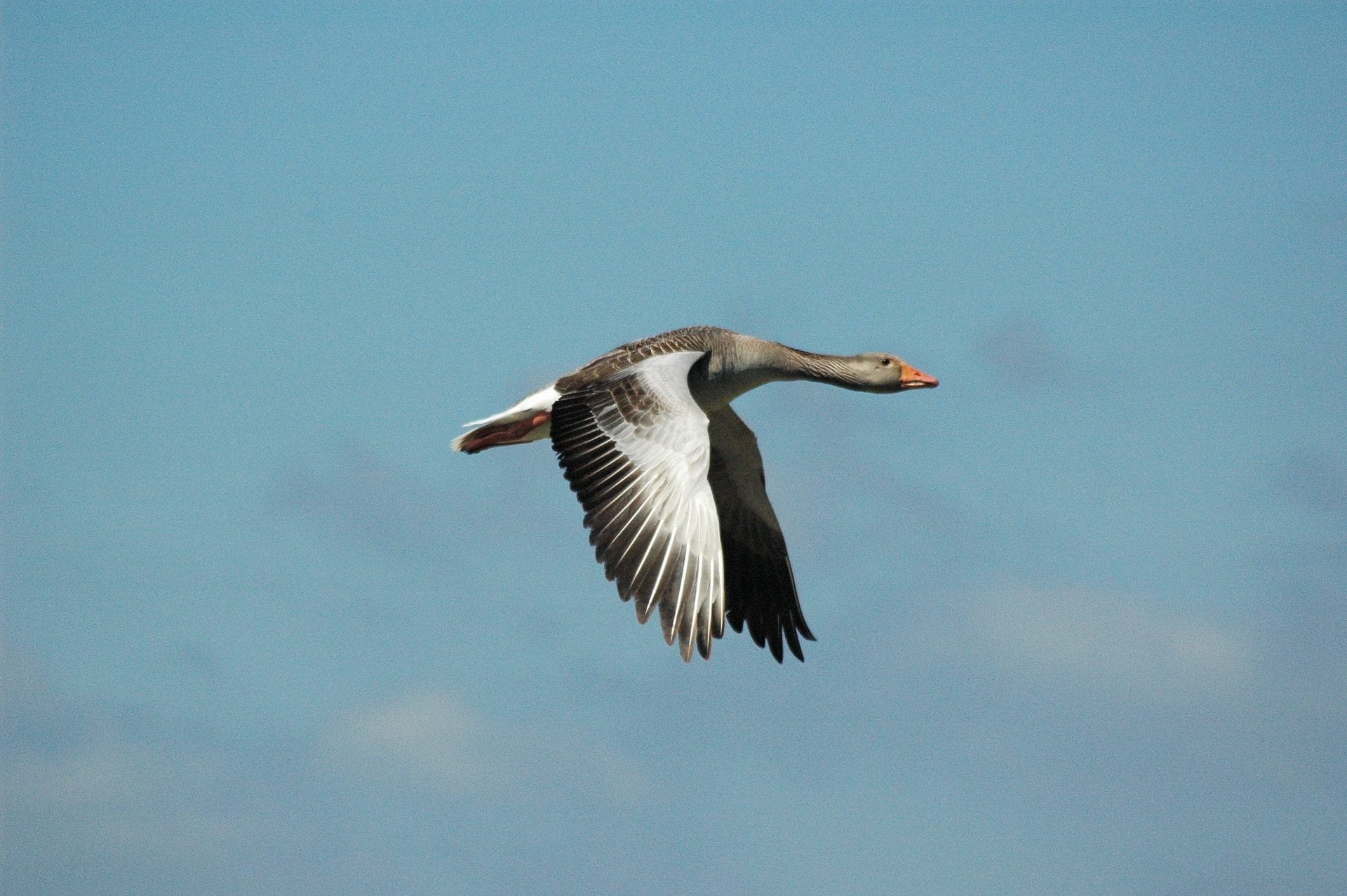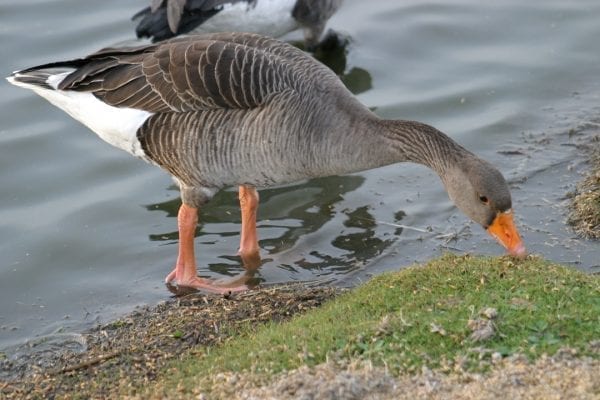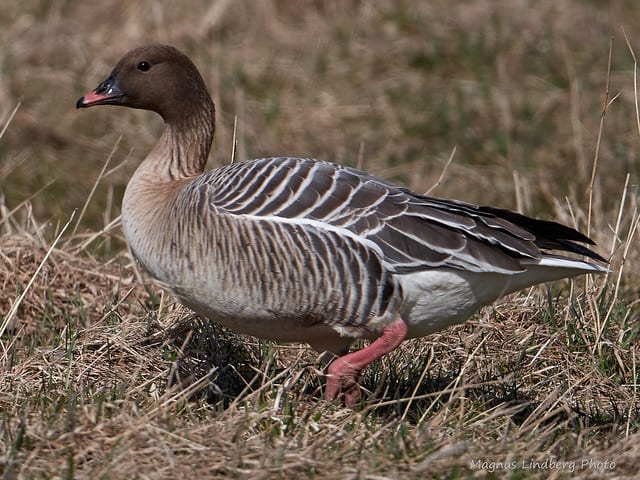
Greylag Goose
| Irish Name: | Gé Ghlas |
| Scientific name: | Anser anser |
| Bird Family: | Geese |
amber
Conservation status
Conservation status
Status
Winter migrant, with Icelandic birds between November & April. Feral birds are present year round.
Identification
Large bulky grey goose, with pinkish-orange bill and dull pink legs. Plumage is plain grey/brown. Some with thin white rim at the base of the bill, and many with dark marks on the belly.
Voice
Nasal cackling noise, trisyllabic, with the first higher pitched.
Diet
Greylag Geese used to concentrate more on estuaries, where they fed on the roots of rushes and sedges. Arable farming in Scotland increased during the post-war years, and appeared to coincide with increasing numbers of Greylag Geese switching to feed on arable farmland. Greylag Geese currently feed mostly on cereal stubble and grassland in their wintering areas.
Breeding
Breeds by lakes and reservoirs, with the nest site often close to water and hidden in reeds or other waterside vegetation. Nests in pairs, but locally colonially.
Wintering
The Icelandic population winters in Scotland and Ireland, occurring mostly at coastal sites. Highly gregarious.
Monitored by
Irish Wetland Bird Survey (I-WeBS). Annual census also carried out in November each season.
Blog posts about this bird

World Migratory Bird Day campaign underscores the importance of insects and shines a light on declines
Saturday, October 12th marks World Migratory Bird Day. By focusing their 2024 campaign on insects, organisers hope to underscore their importance to migratory birds while also highlighting wider concerns related to decreasing insect populations.
The importance of insects for migratory birds and all life
We often hone in on the long distances travelled by migratory bird species and rightly so. It is extremely impressive that such small creatures can fly thousands of miles, often in challenging weather conditions, and arrive at their destination safely. However, many birds are reliant on other species to make this journey possible. Indeed, it is the existence of other winged creatures – insect populations – that gives them the fuel to keep on going.
Insects are essential food sources for many migratory birds on their long journeys, and some species will time their migrations to align with periods of insect abundance in their stopover locations. Once they replenish their energy reserves, they can resume their journey.
Species such as warblers, flycatchers, swallows, and swifts are particularly reliant on insects. However, many other bird species such as ducks and shorebirds depend on insects during migration and at other stages in their lifecycle, in particular for raising their young before they are able to fly.
On a wider level, insects provide critical ecosystem services that support all life on this planet. They pollinate crops which supports food production, decompose waste materials and contribute to nutrient cycling and soil fertility, and control pests. Their decline has a direct impact on ecosystem functioning.
Insect Declines
Many people will recall how, not so long ago, a large number of dead insects would be found on a car windscreen and bumper following a drive through the countryside. Those too young to have experienced this period of insect abundance are likely to have heard this anecdote from friends and family. In fact, it is such a widely shared observation that it has become known to entomologists as the “the windshield phenomenon”.
Anecdotally, insects have experienced declines, but what does the science say? Unfortunately, invertebrates including insects have been historically understudied and many gaps in the data still remain. Additionally, where assessments have taken place, they have predominantly been in regions that can afford to fund insect science such as Europe and North America. Some of the most biodiverse regions on the planet have had little to no assessments of their insect populations. This lack of data on the species we know, coupled with the fact that millions of insect species are yet to be discovered, suggests that we don’t have the full picture on the scale of global insect decline.
However, in recent decades, efforts to better understand how insects are faring have expanded with pollinating insects such as bees, hoverflies, butterflies and moths in particular becoming the subject of an increased amount of research. From what we know so far, the situation is clear: they are in peril.
For example, the International Union for Conservation of Nature (IUCN) European Red List of Bees shows that 9% of the 1,965 species of bee in Europe are Threatened with extinction mainly due to habitat loss as a result of agriculture intensification, urban development, increased frequency of fires and climate change. A further 5.2% are considered Near Threatened. However, a staggering 56.7% of these species were classified as “Data Deficient” meaning that there is not enough data to evaluate their risk of extinction.
Over 37% of the European hoverfly species assessed in the IUCN European Red List of Hoverflies were considered Threatened, with a further 6.9% considered Near Threatened. One species that previously occurred in Sweden, Finland and possibly Poland, was classified as Regionally Extinct.
As outlined in their Red List Strategic Plan (2021-2030), the IUCN is working to substantially increase the number of wild species assessed, particularly plants, invertebrates and fungi.
Insects in Ireland
In Ireland, the National Biodiversity Data Centre is doing trojan work to improve our knowledge of insect populations in Ireland, particularly via monitoring schemes for butterflies, bumblebees and more recently, dragonflies.
The Irish Butterfly Monitoring Scheme, established by the Data Centre in 2008, is Ireland’s longest-running citizen science insect monitoring scheme. By tracking changes in 15 species, we now know that overall butterfly populations have declined by 55% since 2008.
Meanwhile, the All-Ireland Bumblebee Monitoring Scheme has been tracking changes in the populations of the eight most common bumblebee species since 2012. The current overall trend from 2012-2023 is a year-on-year decline of 3.3%.
Celebrate World Migratory Bird Day
World Migratory Bird Day is an annual global campaign dedicated to raising awareness of migratory birds and the need for international cooperation to conserve them. It is organised by a collaborative partnership among two UN treaties – the Convention on Migratory Species (CMS) and the African-Eurasian Migratory Waterbird Agreement (AEWA) – and the non-profit organisation, Environment for the Americas (EFTA).
The return of winter migrants to Ireland brings a seasonal spectacle as thousands of birds, such as Whooper Swans, Greenland White-fronted Geese and Greylag Geese arrive from colder northern regions. This annual migration highlights Ireland's role as a vital sanctuary, providing essential habitats for these species during the harsher winter months. Keep an eye out for some of these species this World Migratory Bird Day but be sure to keep your distance to avoid harmful disturbance.
This year’s insect theme may also encourage you to play your part for Ireland’s insect populations. One way you can do this is by getting involved in the National Biodiversity Data Centre’s citizen science initiatives. Find out more here.

Launch of 45th edition of Irish Birds
The status of Greylag Geese in the Republic of Ireland, mapping of farmland bird hotspots and wintering waterbird trends in Ireland are just some of the many topics covered in the latest edition of Irish Birds.
Published in September 2023, the 45th edition of Ireland’s only ornithological journal is now available for purchase from the BirdWatch Ireland shop and would make the perfect gift for anyone with an interest in birds in Ireland and the latest research in the field of ornithology.
The latest edition of Irish Birds includes an overview of site-level and national trends for 35 wintering waterbird species at the 97 Irish Wetland Bird Survey sites. Across all sites analysed between 1994/95 and 2019/2020, Pochard, Scaup, Goldeneye, Golden Plover, Grey Plover and Lapwing showed large declines of over 50%, while Dunlin and Curlew showed moderate declines. 12 species underwent intermediate declines and the remaining 15 species were stable/ increasing. Further research to determine the drivers of these increases and declines is crucial and will help to shape future conservation efforts.
Farmland birds are one of the most threatened species groups in Europe and many studies have highlighted the declines in population and range of farmland birds in Ireland, the UK and across Europe. The declines, which are affecting sub-groups such as breeding waders and other ground-nesting birds in particular, are attributed to habitat loss and fragmentation, agricultural intensification, land drainage, afforestation and increases in predation. Recognising the important role that agri-environment schemes play in protecting and supporting farmland birds, BirdWatch Ireland has developed a series of maps which illustrate Irish hotspots for 28 species, including Curlew, Lapwing and Yellowhammer. These maps and the methods behind them are included and discussed in another paper – ‘Mapping of Farmland Bird Hotspots: a method to assist targeting of agri-environment measures’ – in the latest edition of Irish Birds.
An assessment of the status Greylag Geese in Ireland during the winter from 2017/18 to 2019/20 showed that the Icelandic population has declined by 42% since the previous assessment in 2007/08. This figure coincides with a c. 45% decline in the flyway population over the same period. Despite these population declines, the distribution of Icelandic Greylag Geese has remained unchanged in the Republic of Ireland over the last 10-12 years, with its concentration being in the eastern half of the country. Meanwhile, the feral population of Irish-breeding Greylag Geese is estimated to have increased by between 109 and 147% since 2008. This study, which was conducted by BirdWatch Ireland in collaboration with the National Parks and Wildlife Service (NPWS), can be read in Irish Birds. To conclude, this paper offers recommendations on how monitoring of Greylag Geese can be expanded upon and improved to help to increase our understanding of this species in Ireland.
Another incredibly informative read is a review paper that looks at the status of birds in County Cork. This paper is a summary of the incredibly detailed book, The Birds of County Cork, by Patrick Smiddy, Mark Shorten and Russ Heselden, which provides a comprehensive account of the ecology of all species known to have occurred in Cork from the earliest times to the present.
Notes on topics such as trichomonosis in finch species and nocturnal migration are some of the other interesting things that owners of Irish Birds can delve into.
The journal also includes a book of abstracts from the 2023 Ornithological Research Conference at University College Cork (UCC) and the Irish Rare Birds Report 2021. The latter is published on behalf of the Irish Rare Birds Committee (IRBC) – a group operating under the auspices of BirdWatch Ireland that is responsible for maintaining a list of the birds recorded in the Republic of Ireland, along with “at sea” records. The Irish Ringing Report 2021, which summarises birds ringed and caught in Ireland in 2021, is also included in the latest Irish Birds. There were many unusual discoveries, including a Kingfisher found in Tallaght which was previously sighted in East Sussex earlier in the year. Such long-distance movements of Kingfishers, especially overseas, are rare. There are also numerous examples of birds that reached a high age, including a Great Tit that was just one month shy of the British Trust for Ornithology (BTO) longevity record of 10 years 5 months and 18 days when it was re-trapped in Edenderry in 2021.
As the number one ornithological journal in Ireland, Irish Birds is a necessity for all serious birdwatchers and scientists working in the Irish conservation sector. The 45th edition of Irish Birds is now available from the BirdWatch Ireland shop, both online and in Kilcoole. Should you choose to support BirdWatch Ireland as a key member, you will receive a copy in addition to three copies of our membership magazine, Wings, every year.
Also, for those seeking previous issues, we have plenty of back issues of Irish Birds available at a reduced price. Whether you are keen to complete a collection or simply have a particular interest in a certain year or study, you can contact us to find out more about purchasing back issues.








